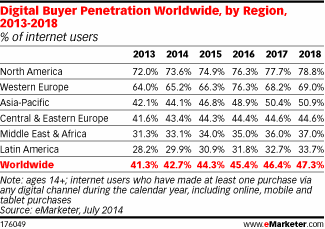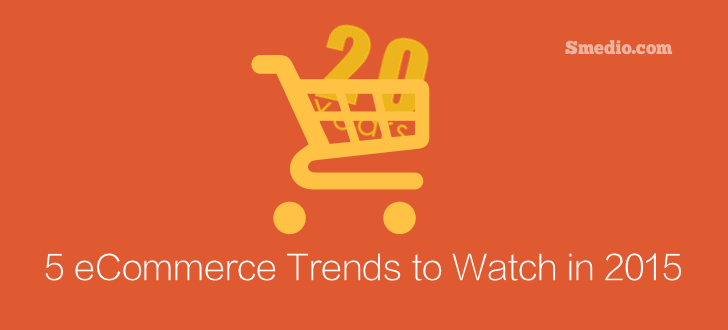With 2015 lurking around the corner, it’s time to ensure your ecommerce site is ready to tackle the challenges the New Year will bring to e-retailers.
 This is going to be a significant year for online retailers as the concept of ecommerce recently turned 20 (if you consider the age of internet payment processing systems). Bigcommerce predicts global B2C ecommerce market will hit record growth in 2015, with revenue of around $2 trillion. According to a study conducted by Emarketer.com, Asia-Pacific is likely to become the top region for ecommerce sales in 2015, followed by North America and Western Europe.
This is going to be a significant year for online retailers as the concept of ecommerce recently turned 20 (if you consider the age of internet payment processing systems). Bigcommerce predicts global B2C ecommerce market will hit record growth in 2015, with revenue of around $2 trillion. According to a study conducted by Emarketer.com, Asia-Pacific is likely to become the top region for ecommerce sales in 2015, followed by North America and Western Europe.
 However, the same study indicates that North America is likely to be in the leading position when it comes to global digital buyer penetration, followed by Western Europe, and then Asia-Pacific.
However, the same study indicates that North America is likely to be in the leading position when it comes to global digital buyer penetration, followed by Western Europe, and then Asia-Pacific.
While these forecasts paint a very encouraging picture for ecommerce websites, success can only be guaranteed if you follow and incorporate the trends. Here are top 5 trends you need to watch out for in 2015.
1. Supply Chain Flexibility
Though the idea of going global is usually seeded in a corporate boardroom, it is the consumers who leverage greater control in pulling brands into new territories. The year 2015 is going to see consumers exerting even more control. A product today can go global even before it is actually manufactured, thanks to crowdsourcing sites and social networks.
Manufacturers are using these marketing gimmicks to create momentum around their products, which in turn gives a lot of power to buyers that is hard to take away. This creates broader market diversity, which is again good news for businesses that were adversely affected by local economic decline. It also means sustainability. But it is easier said than done.
Consumers today expect to have local pricing and a familiar user experience. For an online retailer, this means they need to rethink about their supply chains and local delivery. Here comes the need for supply chain flexibility. You need to offer multiple options, the likes of which include international shipping, in-country fulfilment, and landed cost visibility when entering a market.
2. Rapid In-Store Pickup
A number of markets have already tried the same-day service. Quite a few have failed in their approach mainly because consumers, in most cases, weren’t ready for it. In 2015, rapid in-store/next-day pickup will gain momentum. The in-store experience is playing a significant role in defining buyer behavior. Large online retailers such as Amazon are leveraging this trend to allow consumers in the UK to browse and buy online and use the brick and mortar stores as personal pick-up centers.
U.S.-based online retailers are also embracing this Holy Grail of ecommerce. Brands like Bloomingdale’s, Macy’s and Neiman Marcus are now offering same-day gratification to their online shoppers.
Although eBay Same Day was pulled from the App Store back in November, the company did so to incorporate the service into “eBay’s main mobile app and website” rather than operate it as a standalone application.
This delivery process is more convenient and comes with the advantages of being faster and cheaper. Though tech giants are more likely to experiment with sophisticated bike messengers and drones, most ecommerce sites can offer this facility by keeping warehouses closer to their buying hubs.
Ecommerce is likely to enter into effective partnerships with brick and mortar stores to keep up with consumers’ demand of faster delivery. This will further help online retailers provide free and immediate shipping without incurring additional shipping costs.
3. The Widespread Adoption of Mcommerce
“Mobile platforms account for 60% of total digital media time spent.” – Comscore.com
Mobile platforms, both for smartphones and tablets, will play a significant role in driving ecommerce sales in 2015. Consumers have been using mobile devices for quite some time now to research and browse products but the trend is now on a tremendous upswing with consumers increasingly making purchases on a mobile site or through a shopping app.
Unfortunately, not all ecommerce websites are ready for this. A report from Soasta indicated that 84% of U.S. shoppers interviewed have experienced problems shopping online while 56% agreed they would rather look elsewhere for future shopping due to the issues they encountered. Slow loading speeds, crashing websites and sites not opening properly on their mobile devices were some of the biggest issues faced by these shoppers.
It is indeed surprising to see that though mobile commerce is becoming increasingly popular, some e-retailers are yet to optimize their sites for different mobile devices. According to Internet Retailing, less than half (45%) of online shoppers are happy with their mobile shopping experience.
4. The Utopia of Omni-Channel Marketing
 Allow your customers to access your products using different channels such as desktop, mobile devices, and even brick-and-mortar stores. Shoppers today go through physical stores, look up products online, often scan a QR code for deals, and visit the brick-and-mortar store to purchase/collect the item(s). Omni-channel consumers are shaping the future of brick-and-mortar and ecommerce stores alike. The experience, however, must be seamless and similar regardless of the channel used.
Allow your customers to access your products using different channels such as desktop, mobile devices, and even brick-and-mortar stores. Shoppers today go through physical stores, look up products online, often scan a QR code for deals, and visit the brick-and-mortar store to purchase/collect the item(s). Omni-channel consumers are shaping the future of brick-and-mortar and ecommerce stores alike. The experience, however, must be seamless and similar regardless of the channel used.
Make use of responsive design to deliver seamless user experience across devices. Be available on social channels so that consumers are able to interact and engage with you whenever they need to.
The shopping decisions of consumers are increasingly blurring the lines between online and offline retailing. While they scan products for more information, reviews and deals while shopping in physical stores, they also browse product details online and visit local stores to buy the same.
Marketers are having a hard time delivering timely, integrated and coordinated customer experiences that exceed the expectations of hyper-connected customers. In 2015, they will have to do a far better job of optimizing cross-channel interactions with their customers than they’re doing now.
5. Loyalty through Deals Combined with Personalization
Turning one-time shopper into a loyal customer is a challenge for many retailers, regardless of whether the business is online or physical. Deals and discounts have been the only truly sustainable way to retain customers and motivate them to come back for more. From first-time shopping discounts to holiday deals and referral discounts, ecommerce sites have used a number of offers to gain new customers and sustain the old ones.
However, discerning customers (whose numbers are increasing exponentially) are settling off for a trade-off between commodities and highly personalized goods – the middle ground of mass customization. These customers want goods that provide the elusive “value for money” i.e. products that conform to their tastes, allow them to stand out from their peers, and don’t cost an arm and a leg.
Retailers not only recognize this this trend, but are also responding to it. Take the example of Ownonly, the online men’s fashion retailer. Their value offering is made-to-measure suits based on customer-selected style with fitting tailored to individual preferences, including fabric, color, cut, buttons, etc. all specifiable on the website.

However, “custom” isn’t synonymous with “expensive” here. Ownonly runs a discount in conjunction with a referral scheme to gain and retain customers. The ploy is to grab attention of one-time shoppers with the discount, encourage them to refer the site to their social circle, and then come back to cash on rewards earned from the referral program.

Finally, offering huge discounts during the holiday season is nothing new and is likely to continue, with promotions starting earlier and becoming more frequent.
Don’t Ring Out the Old
2015 is likely to be truly the year of the consumers (again) as they’ve been bestowed with more power than ever. People will seek out more sincerity from brands; retailers need to give even more importance to their buying behavior when strategizing their ecommerce efforts. The New Year will bring a lot to the online retail industry, but some of the old favorites will continue to drive sales. E-retailers therefore need to balance the old and the new to keep up with the latest industry trends.
[et_social_share]










4 comments
Comments are closed.